选修六 Unit4 reading
- 格式:ppt
- 大小:4.63 MB
- 文档页数:43
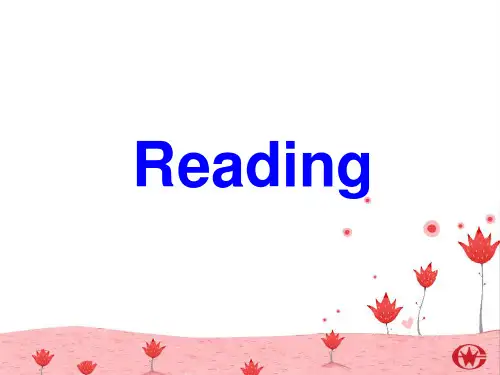
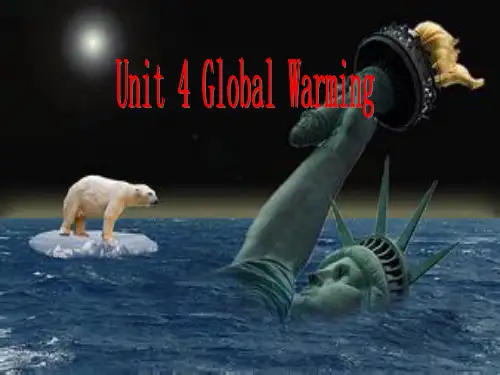
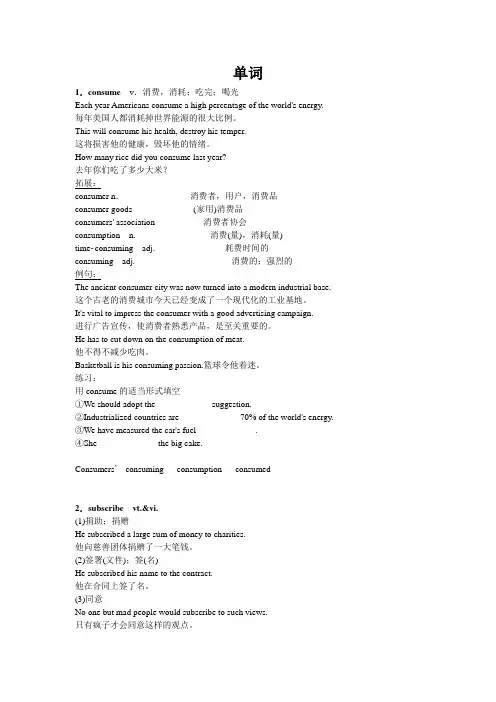
单词1.consume v.消费,消耗;吃完;喝光Each year Americans consume a high percentage of the world's energy.每年美国人都消耗掉世界能源的很大比例。
This will consume his health, destroy his temper.这将损害他的健康,毁坏他的情绪。
How many rice did you consume last year?去年你们吃了多少大米?拓展:consumer n.消费者,用户,消费品consumer goods (家用)消费品consumers' association 消费者协会consumption n. 消费(量),消耗(量)timeconsuming adj. 耗费时间的consuming adj. 消费的;强烈的例句:The ancient consumer city was now turned into a modern industrial base. 这个古老的消费城市今天已经变成了一个现代化的工业基地。
It's vital to impress the consumer with a good advertising campaign.进行广告宣传,使消费者熟悉产品,是至关重要的。
He has to cut down on the consumption of meat.他不得不减少吃肉。
Basketball is his consuming passion.篮球令他着迷。
练习:用consume的适当形式填空①We should adopt the ____________ suggestion.②Industrialized countries are _____________ 70% of the world's energy.③We have measured the car's fuel _____________.④She _____________ the big cake.Consumers’consuming consumption consumed2.subscribe vt.&vi.(1)捐助;捐赠He subscribed a large sum of money to charities.他向慈善团体捐赠了一大笔钱。
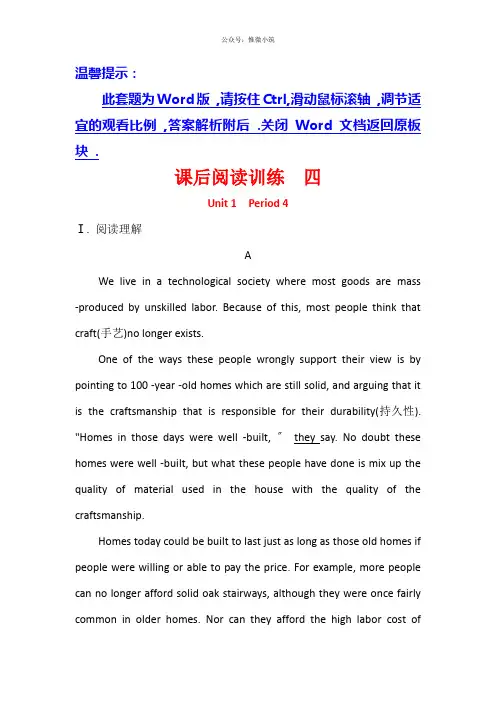
温馨提示:此套题为Word版,请按住Ctrl,滑动鼠标滚轴,调节适宜的观看比例,答案解析附后 .关闭Word文档返回原板块 .课后阅读训练四Unit 1Period 4Ⅰ. 阅读理解AWe live in a technological society where most goods are mass -produced by unskilled labor. Because of this, most people think that craft(手艺)no longer exists.One of the ways these people wrongly support their view is by pointing to 100 -year -old homes which are still solid, and arguing that it is the craftsmanship that is responsible for their durability(持久性). "Homes in those days were well -built, 〞they say. No doubt these homes were well -built, but what these people have done is mix up the quality of material used in the house with the quality of the craftsmanship.Homes today could be built to last just as long as those old homes if people were willing or able to pay the price. For example, more people can no longer afford solid oak stairways, although they were once fairly common in older homes. Nor can they afford the high labor cost ofemploying a carpenter to build the stairway. Yet if someone can pay the high cost, there are still plenty of carpenters around able to make those stairways. And not only would these carpenters know how to build them, they would probably do a better job than carpenters of old days.One thing the modern carpenter has which enables him to do a better job is much more advanced tools. Such tools as laser beams and power planes help them lay out a house better and make more precise cuts(精确切割)on the wood. Also, it is not uncommon any more to find carpenters with college degrees and carpenters with a solid knowledge of mathematics, which would enable them to deal with more difficult house designs.The problem of modern quality, then, really boils down to the problem of material, for the modern carpenter is just as able to produce craftsmanship as the carpenter of fifty years ago, but only if given proper material.【语篇概述】本文是议论文.文章对现代社会的工匠的手艺有没有消亡这一问题进行了讨论.最|后, 作者认为工匠的手艺不但没消亡, 反而增强了.1. What does the underlined word "they〞(Paragraph 2)refer to?A. Carpenters who are fond of oak stairways.B. Carpenters who have college degrees.C. People who think highly of carpenters of old days.D. People who think that modern material is of low quality.【解析】选C .词义猜想题.根据第二段最|后一句"毫无疑问, 这些家被建得很好, 但是这些人所做的是把用在房屋上的材料的质量与他们精湛的手艺结合起来了.〞这说明有此观点的人是赞扬古代工匠的人.2. Compared with the carpenters in the past, modern carpenters are__________.A. more successfulB. more learnedC. more imaginativeD. more hardworking【解析】选B .细节理解题.根据第三段最|后一句及第四段可知, 现代的工匠比古代的工匠更有学问.3. What does the third paragraph mainly discuss?A. People in the past preferred to use oak to build stairways.B. It is now expensive to employ a carpenter.C. Modern houses last as long as the old one.D. Good carpenters still exist in modern times.【解析】选D .段落大意题.根据第三段第|一句可知, 如果人们愿意付钱, 现代的工匠也能建造出和那些老房子持续得一样长久的房子.4. What would be the best title for the text?A. Is Craft Dead?B. Craft, Back to Life?C. History of CraftsmanshipD. Carpenters Today and Yesterday【解析】选A .标题归纳题.根据第|一段可知, 现代多数人认为随着科技的开展, 工匠的手艺不复存在了.下文就此问题展开讨论.经过分析, 作者认为现代工匠的手艺没有消亡, 而是更先进了.故用A作标题更能吸引读者.其余三项偏离了中|心或是平淡无奇.BA few years ago, a company called Space Marketing came up with a plan to send a mile -long advertisement into space. To advertising agencies(机构), it would have been "a dream come true〞. However, advertising standards agencies finally decided not to allow Space Marketing to go ahead with their plans and they were forced to give them up.Space may indeed be the final place for advertisers, because on Earth we are already surrounded by advertising wherever we are and whatever we are doing. Apart from the obvious adverts that we see every day on TV, and in newspapers and magazines, there is a whole "other world〞of advertising messages for our attention. There are ads that we see on the side of the bus we catch to work, for example. And what about the logos(商标)we see on the clothing of the people we walk past in the streets?Most of the time, we are probably not even aware of(意识到的)these less obvious advertising methods, but that doesn ,t mean thatthey don ,t work. Take "product placement〞for example. You are in a cinema, watching the latest Hollywood movie. Look carefully at the make of the car your favorite actor is driving. And what about his watch? Can you see what brand it is? Chances are, you can, and the company that owns the brand is likely to have paid thousands for it to appear in the film.So, whether Space Marketing finally succeeds in sending ads into space or not is perhaps less important than it might seem. This would not change a thing. Our everyday lives are already strongly influenced by advertising whether we realize it or not.【语篇概述】我们的生活中出现了大量的广告, 本文介绍了一家叫Space Marketing的公司提出把一个一英里长的广告送到太空的想法.5. What happened to the plan of sending an ad into space?A. It came to nothing.B. It was a dream come true.C. It had to wait a few years before it was carried out.D. It was supported by the advertising standards agencies.【解析】选A .细节理解题.根据第|一段最|后一句中they were forced to give them up. (他们被迫放弃.)可知这个方案没有被实施.6. How does the author explain the "other world〞of advertising messages?A. By showing research findings.B. By explaining research findings.C. By giving instructions.D. By using examples.【解析】选D .细节理解题.根据下文中There are ads that we see on the side of the bus we catch to work, for example. And what about the logos we see on the clothing of the people we walk past in the streets? 可看出作者是通过举例子来解释"other world〞.7. As a form of advertising, product placement__________.A. costs a littleB. doesn ,t workC. is less obvious than TV adsD. mainly appears in Hollywood movies【解析】选C .推理判断题.根据文章第三段中Most of the time, we are probably not even aware of these less obvious advertising methods, but that doesn ,t mean that they don ,t work. Take "product placement〞for example. 可知"product placement〞是不太明显的广告.8. What does the author suggest at the end of the text?A. We live in a world of advertising.B. We ,ve changed a lot because of advertising.C. Space Marketing leads in the advertising industry.D. Space ads will mark the beginning of a new world.【解析】选A .推理判断题.根据文章最|后一句Our everyday lives are already strongly influenced by advertising whether we realize it or not. 无论我们意识到与否, 我们的日常生活已经被广告深深地影响到了.故作者认为我们生活在一个充满广告的世|界.Ⅱ. 完形填空The name of the1artist Picasso is very famous in the West. Today Picasso2"art〞. Picasso started off with various styles of painting until he invented "Cubism(立体派)〞.Picasso ,s father was also a painter, a Professor of Art at the local school of fine arts(美术). He taught his son how to draw figures and how to paint3oils and took him to some of the schools of art that he himself4at. Although he was Spanish, Picasso spent much of his life in Paris and never took part in5the Spanish Civil War, World WarⅠor World WarⅡ.Picasso ,s6life was very unconventional(非传统的). He had four children7three different women. In 1961, however, he married and stayed with Jacqueline Roque8the end of his life in 1973.Picasso produced paintings of acrobats(杂技演员)at the beginning of his9and moved into a different style when he started painting pictures of artists. 10he developed his works into the famous style which is known as "Cubism〞. He also created11and wrote poetry.Picasso produced12paintings than anyone else ever has: 13,500 paintings, 100, 000 prints and 34, 000 book illustrations. He worked in many different mediums(手段): oils, watercolors, charcoal and pencil. His paintings in the Cubist style started a new movement in art in the 1320th century. Picasso14this style of painting with a colleague, Georges Braque in 1909. They painted objects by15them into small pieces and then viewed and painted them from several angles at once. 16used brown colors for the paintings.The Cubism Movement started with Picasso and Braque in Montmartre, Paris, and17rapidly among the artists. It began to develop into a second phase(阶段), in which artists added18objects to the painting in various materials, such as cloth or newspapers. In the 1950’s Picasso ,s works went through more changes when he started to look at the grand masters of art, like Velasquez.In his 80’s and 90’s he began to paint a mixture of many styles19 he kept changing. Only after his death did people fully20his great achievements and in 1999 one of his paintings sold for $51 million. 【语篇概述】本文主要介绍了伟大艺术家毕加索的生活及其作品风格等.1. A. French B. English C. Spanish D. German【解析】选C .词汇复现题.从第二段的Although he was Spanish, 可看出毕加索是西班牙人.2. A. is B. meansC. learnsD. makes【解析】选B .逻辑推理题.从"art〞的引号可看出此处是比喻意义, "今天, 毕加索意味着艺术〞, 说明毕加索成了艺术的化身.3. A. with B. on C. from D. in【解析】选D .习语搭配题.根据动词paint和oils看出此处表达的是"怎样用油彩绘画〞, oil加s, 表示绘画中使用的油彩.in表示用某种材料绘画、涂抹等.4. A. played B. studiedC. livedD. taught【解析】选D .逻辑推理题.上句说毕加索的父亲是当地一所美术学校的教授, 故常带儿子去他教学的学校学习画画.5. A. among B. eitherC. betweenD. beyond【解析】选B .习语搭配题.空白处后有三个事物, 很容易选A项, among后的宾语应该是复数形式; between和and连用; beyond表示"在……之外〞; 根据or, 此处选B项, 构成"either. . . or. . . 〞, 表示"或者……或者……〞.6. A. real B. old C. public D. private【解析】选 D .逻辑推理题.从下文的"He had four children__________three different women. 〞看出此处是私生活, private "私人的, 私有的〞.7. A. by B. in C. on D. about【解析】选A .逻辑推理题.根据different可以看出, 他的四个孩子是由三个不同的女人所生的, 此处by表示由某人所生.8. A. until B. at C. as D. by【解析】选A .背景常识题.毕加索和Jacqueline Roque待在一起直到毕加索生命的结束.until表示某个动作持续到某个时间.9. A. life B. careerC. paintingsD. school【解析】选B .逻辑推理题.从"moved into a different style〞看出此处指他绘画生涯的开始.10. A. Accidentally B. FranklyC. EventuallyD. Fortunately【解析】选C .词语辨析题.在这一段讲述了三个时间段, 一是at the beginning; 二是when he started; 三是此空白处.从"he developed his works into the famous style which is known as‘Cubism ,〞看出这是顶峰时期, 应该填入"最|后〞之意.A项"偶然地〞; B项"坦率地〞; D项"幸运地〞.11. A. sculptures B. telephonesC. picturesD. poems【解析】选A .逻辑推理题.also说明他还有两项爱好, 一是空白处, 二是写诗.poetry是诗的总称, D项poems与poetry重复; C项与上文的paintings重复; 由常识可知B项并不是毕加索创造的; 只有A 项"雕塑〞, 符合文意.12. A. fewer B. better C. worse D. more【解析】选D .习语搭配题.此处构成more. . . than结构, 由下文的作品数量就可推断出他的作品"多于〞其他人, 不可能用fewer than "少于〞.13. A. late B. modernC. earlyD. difficult【解析】选C .逻辑推理题.从下文的"in 1909〞以及下一段的"The Cubism Movement started with Picasso and Braque. . . 〞看出此处是指20世纪早期, 应填early .14. A. found B. inventedC. searchedD. protected【解析】选 B .词汇复现题.由第|一段". . . until he invented‘Cubism ,〞可知Cubist style是他创造的, 用invent .15. A. separating B. puttingC. throwingD. dividing【解析】选D .逻辑推理题.由"into small pieces〞可以看出, 是把某物分割成碎片, 应选dividing .16. A. He B. It C. They D. We【解析】选C .逻辑推理题.此处They指毕加索和他的同事.从"used brown colors〞看出主语应该是人, 与上文with a colleague照应.17. A. speeded B. wentC. spreadD. wide【解析】选C .词语辨析题.从"rapidly among the artists〞看出此空白处应该填谓语动词, spread的过去式、过去分词同原形; spread rapidly among the artists意为"迅速在艺术家中传播开〞.18. A. same B. differentC. specialD. extra【解析】选D .逻辑推理题.由"artists added〞看出, 艺术家要添加一些东西, 既然添加, 那就是在原有根底上, 再加上额外的物体, 因此, 此处填入extra .从文中in various可以排除A项和C项; B项与various 重复.19. A. when B. that C. who D. what【解析】选B .句式结构题.由语境及句式结构可知, he kept changing 作styles的定语, 且从句中缺少宾语, 应选B .20. A. watch B. observeC. appreciateD. look【解析】选C .词语辨析题.直到毕加索死后, 人们才充分领略到他的伟大成就.appreciate欣赏; watch观看; observe观察; look看.Ⅲ. 短文改错假定英语课上老师要求同桌之间交换修改作文, 请你修改你同桌写的以下作文.文中共有10处语言错误, 每句中最|多有两处.每处错误仅涉及一个单词的增加、删除或修改.增加: 在缺词处加一个漏字符号(∧), 并在其下面写出该加的词.删除: 把多余的词用斜线(\)画掉.修改: 在错的词下画一横线, 并在该词下面写出修改后的词.注意: 1. 每处错误及其修改均仅限一词;2. 只允许修改10处, 多者(从第11处起)不计分.An old man had been waiting for the bus stop. After a few minutes, the bus arrived and did not stop. The man who thought it would stop a bit farther, so he started running after the bus. Fortunately, the bus never stop. The man kept follow the bus until he realized that he arrived home. The man was very happy that he could save a bit money. He happily told his wife, "Honey, today I ran after the buses until arriving home. I didn ,t have to pay the fee. 〞Surprising, the wife blamed her husband, "Do you know how many you could save if you ran after a taxi? 〞答案:【技法导练】完形填空- -前后照应前后照应是考查考生根据上下文提示信息进行对照分析及推理的能力.做题时, 考生要正确借助"前置信息〞"后置信息〞"前后信息〞才能做出正确的选择.请按照以下提示题号找出对应信息.运用前置题号原文信息句选项10Picasso produced paintings of acrobats at the beginningof his. . . . and moved into a different style when hestarted painting pictures of artists.- - -答案:Eventually; invented; Spanish; private; dividing关闭Word文档返回原板块。
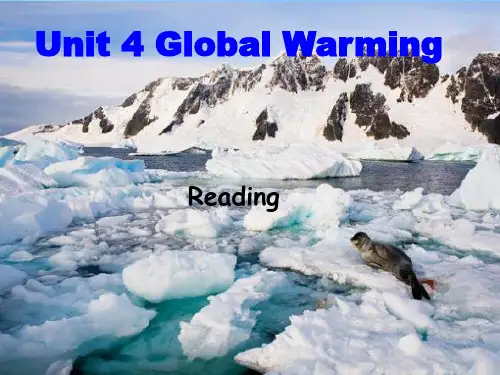


选修六unit 4(每日词汇)指人的名词educator[ˈedju:keitə]n.教育工作者;教育家记“意”笔记1:联想背过的单词education教育。
记“意”笔记2:e-向外,出现。
duc引导。
参考introduce介绍;conduct指挥,指导;product产品。
-ate动词后缀。
educate =(把内心的东西)向外引导出来= 教书育人= 教育。
educat-or 做教育的人。
environmentalist[inˌvaiərən'mentlist]n.环境保护论者记“意”笔记1: 联想背过的单词environment环境。
记“意”笔记2:en-进入。
viron-环绕。
-ment,-al,-ist都是后缀。
individual[ˌindiˈvidʒuəl]n.个人;个体记“意”笔记:in-进入;处于……状态。
divid-分开;分离。
-ual 形容词后缀。
in-divid-u-al = 处于分隔开的状态= 个体;个人。
指物的名词appliance[əˈplaiəns]n.用具;工具;器具记“意”笔记:联系单词apply 申请;应用。
变y为i, ance为名词后缀。
appliance = 应用的东西= 工具;用具;器具。
其他相关单词application 申请;应用。
applicant 申请人。
byproduct['baiˌprɔdʌkt]n.副产品记“意”笔记:by-随着;在……一边。
product 产品。
byproduct = 随着主产品出现的= 副产品。
其他相关单词passer-by 过路人。
can[kæn]n.容器;罐头记“意”笔记:can you can a can ? 你能装一个罐子吗?data[ˈdeitə]n.资料;数据记“意”笔记1:联想熟悉的组合big data 大数据。
database 数据库。
记“意”笔记2:比较date日期flood[flʌd]n.洪水;水灾记“意”笔记:fl-指水。

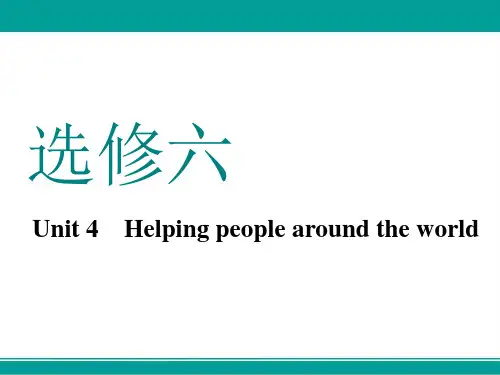
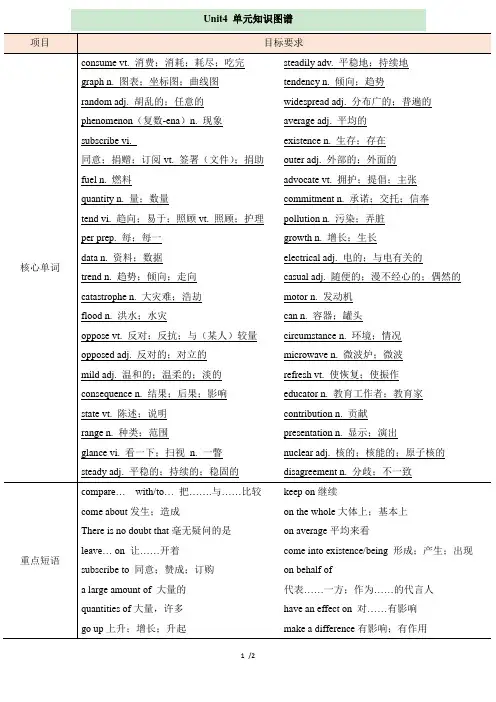
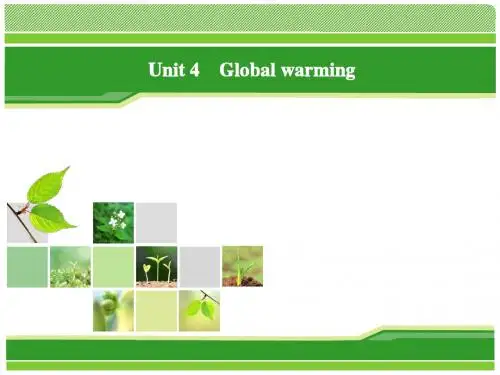
Unit4 阅读课名师教学设计Book 6 Unit 4 Global Warming What can we do about global warming?Reading & WritingTeaching objectives:1. Language and skillsStudents can predict the content of a letter in reply.Students can scan the passage and find out the specific information. Students can guess the meaning of the word according to the context.Students can understand when to use imperative sentences and the effect it creates. Students can design a slogan.Students can make a poster that tells various ways they can reduce the amount of carbon dioxide by using imperative sentences.2. Cultural awarenessStudents will be aware of the importance of reducing the amount of carbon dioxide and be an educator3. Learning strategiesStudents will cultivate their abilities by doing some activities independently and some in groups.Students will communicate with each other in English while doing the group work. Difficult points:To help the students to understand how they use the energy will affect the amount of global warming and think about what they can do about it.Teaching Aids:Picture display, slides, reading, discussion and writing.Teaching Procedures:1. lead-inShow a video of a baby polar bear being eaten by an adult bear to make students realize the environment has been changing because of the effect of global warming. Show a mind map to explain what causes global warming.2. readingStep 1Read the first letter and predict what the second letter is about.Step 2Skim for different views of the two letter on whether individuals have effect on environmental problems.Scan for suggestions and fill in the form.Guess what the word “count” mean according to the context.Step 3Explain the special effects the imperative sentences create and when to use them. Learn how to put forward a slogan.Step 4Show some examples and discuss whether it helps to reduce the amount of carbon dioxide.3. writingShow a video of a student’s daily life to see if there is anything he can do to reduce the amount of carbon dioxide.Group task: make a poster with your group members for your class that tells students various ways they can reduce the amount of carbon dioxide in the air. Remember to use imperative sentences in your poster.4. homeworkWriter a passage on what individuals can do about global warming.。
THE EARTH IS BECOMING WARMER-BUT DOES IT MATTER?During the 20th century the temperature of the earth rose about one degree Fahrenheit. That probably does not seem much to you or me, but it is a rapid increase when compared to other natural changes. So how has this come about and does it matter? Ea rth Care’s Sophie Armstrong explores these questions.There is no doubt that the earth is becoming warmer (see Graph 1) and that it is human activitythat has caused this global warming rather than a random but natural phenomenon.All scientists subscribe to the view that the increase in the earth's temperature is due to the burning of fossil fuels like coal, natural gas and oil to produce energy. Some byproducts of this process are called "greenhouse" gases, the most important one of which is carbon dioxide. Dr Janice Foster explains: "There is a natural phenomenon that scientists call the 'greenhouse effect'. This is when small amounts of gases in the atmosphere, like carbon dioxide, methane and water vapour, trap heat from the sun and therefore warm the earth. Without the 'greenhouse effect', the earth would be about thirty-three degrees Celsius cooler than it is. So, we need those gases. The problem begins when we add huge quantities of extra carbon dioxide into the atmosphere. It means that more heat energy tends to be trapped in the atmosphere causing the global temperature to go up."We know that the levels of carbon dioxide have increased greatly over the last 100 to 150 years. It was a scientist called Charles Keeling, who made accuratemeasurements of the amount of carbon dioxide in the atmosphere from 1957 to 1997. He found that between these years the carbon dioxide in the atmosphere went up from around 315 parts to around 370 parts per million(see Graph 2).All scientists accept this data. They also agree that it is the burning of more and more fossilfuels that has resulted in this increase in carbon dioxide. So how high will the temperature increase go? Dr Janice Foster says that over the next 100 years the amount of warming could be as low as 1 to 1.5 degrees Celsius, but it could be as high as 5 degrees.However, the attitude of scientists towards this rise is completely different. On the one hand, Dr Foster thinks that the trend which increases the temperature by 5 degrees would be a catastrophe. She says, "We can't predict the climate well enough to know what to expect, but it could be very serious." Others who agree with her think there may be a rise of several metres in the sea level, or predict severe storms, floods, droughts, famines, the spread of diseases and the disappearance of species. On the other hand, there are those, like George Hambley, who are opposed to this view, believe that we should not worry about high levels of carbon dioxide in the air. They predict that any warming will be mild with few bad environmental consequences. In fact, Hambley states, "More carbon dioxide is actually a positive thing. It will make plants grow quicker; crops will produce more; it will encourage a greater range of animals - all of which will make life for human beings better."Greenhouse gases continue to build up in the atmosphere. Even if we start reducing the amount of carbon dioxide and other greenhouse gases, the climate is going to keep on warming for decades or centuries. No one knows the effects of global warming. Does that mean we should do nothing? Or, are the risks too great? WHAT CAN WE DO ABOUT GLOBAL WARMING?Dear Earth Care,I am doing a project on behalf of my school about global warming. Sometimes I feel that individuals can have little effect on such huge environmental problems. However, 1 still think people should advocate improvements in the way we use energy today. As I'm not sure where to start with my project, I would appreciate any suggestions you may have.Thank you!Ouyang GuangDear Ouyang Guang,There are many people who have a commitment like yours, but they do not believe they have the power to do anything to improve our environment. That is not true. Together, individuals can make a difference. We do not have to put up with pollution. The growth of the greenhouse gas, carbon dioxide in the air actually comes as a result of many things we do every day. Here are a few suggestions on how to reduce it. They should get you started with your project.1 We use a lot of energy in our houses. It is OK to leave an electrical appliance on so long as you are using it - if not, turn it off! Do not be casual about this. So if you are not using the lights, the TV, the computer, and so on, turn them off. If you are cold, put on more clothes instead of turning up the heat.2 Motor vehicles use a lot of energy- so walk or ride a bike if you can.3 Recycle cans, bottles, plastic bags and newspapers if circumstances allow you to. It takes a lot of energy to make things from new materials, so, if you can, buy things made from recycled materials.4 Get your parents to buy things that are economical with energy - this includes cars as well as smaller things like fridges and microwaves.5 Plant trees in your garden or your school yard, as they absorb carbon dioxide from the air and refresh your spirit when you look at them.6 Finally and most importantly, be an educator. Talk with your family and friends about global warming and tell them what you have learned.Remember - your contribution counts! Earth Care。